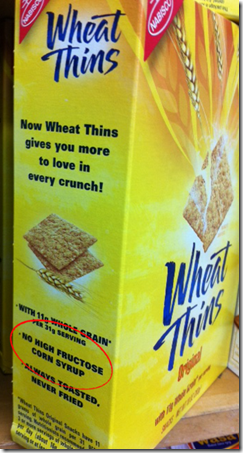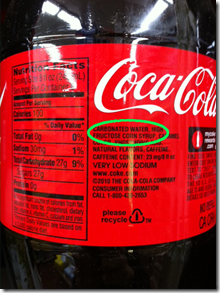What’s All the Fuss about High-Fructose Corn Syrup?
 Sigh…the news these days is always depressing – this causes cancer, that causes obesity, everything shortens your life-span, and so on. One barely knows what’s safe to eat anymore!
Sigh…the news these days is always depressing – this causes cancer, that causes obesity, everything shortens your life-span, and so on. One barely knows what’s safe to eat anymore!
In that vein, we’ve been hearing a lot over the past 5 or 10 years about the “dangers” of high-fructose corn syrup, and many soft drinks and foods now specifically advertise that they don’t contain high-fructose corn syrup. So what is all the fuss about? What is high-fructose corn syrup (aren’t fructose and corn pretty natural??) and is it worse for you than other sweeteners like table sugar?
A friend recently asked me a number of questions about the differences between high-fructose corn syrup and other sugars, so I decided to do some digging. I realized that I had relatively few answers to my friend’s questions – my knowledge pretty much extended to the commercial warnings I’d heard that high-fructose corn syrup (which I shall, in very lawyerly-fashion, define as “HFCS”) was “bad” for me. And so we begin….
What is High-Fructose Corn Syrup (HFCS)?
Basic chemistry: the most common and well-known form of sugar in American households is undoubtedly table sugar, which is made from sugar cane. Table sugar is actually composed of two other sugars: 50% glucose and 50% fructose.
HFCS, like table sugar, is also composed of glucose and fructose. However, the proportions are slightly different in HFCS. The typical proportions of HFCS (as you might find in the HFCS used in soft drinks) are 55% fructose and 42% glucose (with 3% other sugar molecules ). Chemically, then, HFCS is really not that different from the white, powdery table sugar that people have used for centuries. In fact, it not very different at all from that “all-so-natural-and-healthy” honey (which also has slightly higher concentrations of fructose than glucose).
Where does HFCS come from?
I know it comes as a complete shock to you, but high-fructose corn syrup is manufactured from…um…corn. Without getting too “science-y,” they start with corn syrup, which is 100% glucose, and add some enzymes to convert some of the glucose into fructose. This process is slightly more complicated but not really all that different than the process used to process table sugar out of sugar cane.
Given that HFCS isn’t all that different chemically or process-wise from table sugar…
Why do so many food manufacturers use HFCS?
 After all, it seems odd to go through the hassle of doing extra processing just to create a sugar that’s similar in so many ways to table sugar. But, as with most things in life, it’s all about the $money$.
After all, it seems odd to go through the hassle of doing extra processing just to create a sugar that’s similar in so many ways to table sugar. But, as with most things in life, it’s all about the $money$.
It surprised me somewhat, but HFCS is generally only used in the US. For example, most Coca Cola sold outside of the US is made from “real” cane sugar, but HFCS is used in US Coca Cola. So why is it cheaper to use HFCS in the US? Shouldn’t the more complicated processing actually make HFCS more expensive?
The answer lies with the US government, which has subsidized corn production forever (ok, not quite literally, but for a very long time). This has resulted in lower HFCS prices than sugar prices. In addition, the US does not limit production of HFCS unlike in Europe, which generally has quotas for the production of HFCS. Because of the price differential, HFCS became the popular sweetener of choice in America. However, its use has steadily declined in recent years due to concerns about its impact on health (although many foods, e.g., Special K and Oreos, still use HFCS).
Is HFCS bad for you?
To keep the suspense level down, I’ll give you the conclusion first. There are a few studies linking HFCS to obesity (most recently, a Princeton study found rats gained more weight eating HFCS than table sugar even when their overall caloric intake was the same) and higher risks of heart disease, but these studies are nowhere close to conclusive (in fact, I’d be highly skeptical of the conclusions drawn in the heart disease study!). In general, whether it’s HFCS or any other type of sugar that they’re putting in, it’s going to add a lot of calories to your diet, and they’re calories that add zero nutritional value to your diet!
Although the studies are pretty inconclusive at this point, it is possible that HFCS is marginally worse for you than table sugar. Many scientists postulate that this difference is due to the higher fructose concentrations in HFCS. Fructose has recently been highlighted by several scientists and health writers as being the worst of the sugars, and this may be a good reason to abandon HFCS, although don’t forget that cane sugar is really not that much better! And if we’re throwing dirt on fructose and anything containing high levels of fructose, then we should also be worried about honey (which contains more fructose than glucose) and agave (which is mostly fructose, almost 90%). So, while the media and public opinion paints devil horns on any products containing HFCS, maybe you should be considering what you’re sweetening your foods and drinks with…it may be even worse for you than HFCS.
P.S. In a last ditch attempt to save HFCS, the corn industry is planning to rename it to “corn sugar” to curb “consumer confusion.” Do you think this new name will make you feel safer about consuming the product? Feel free to comment below.
